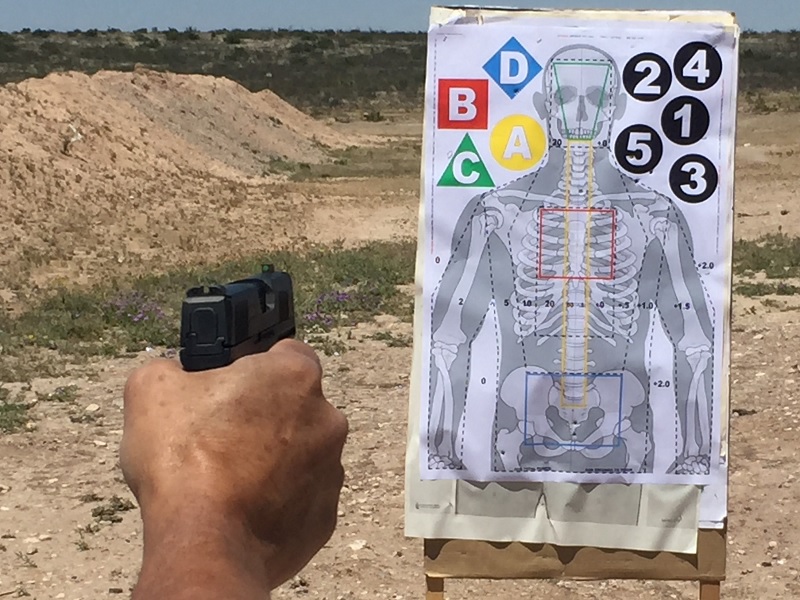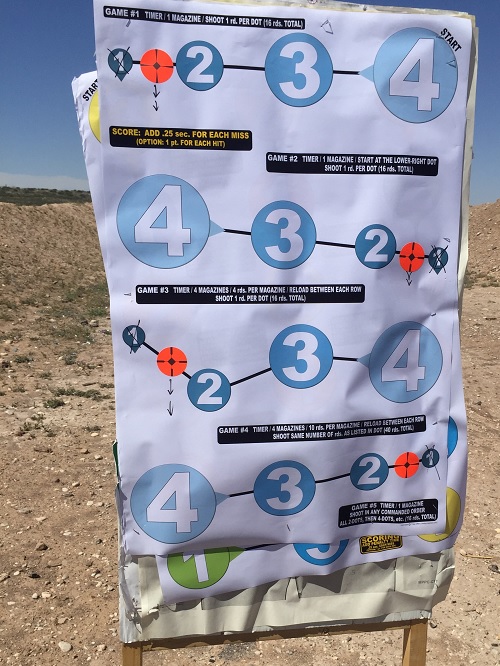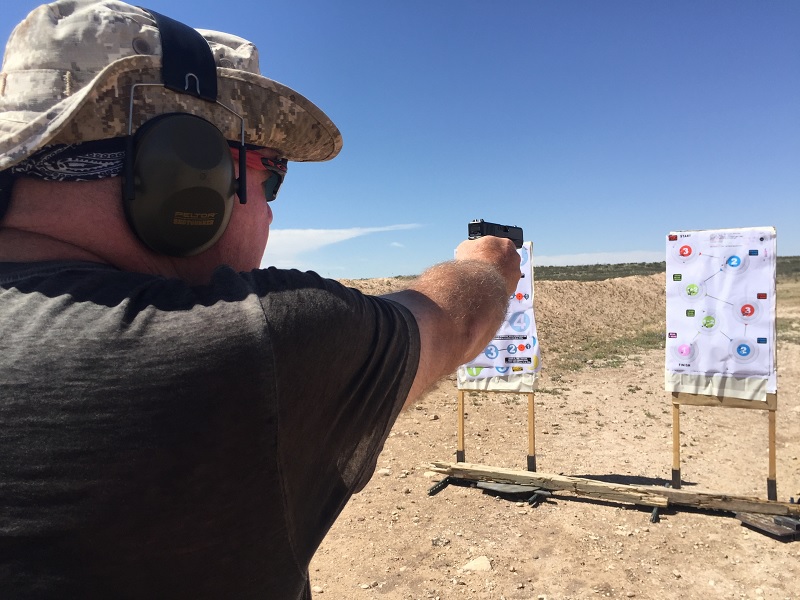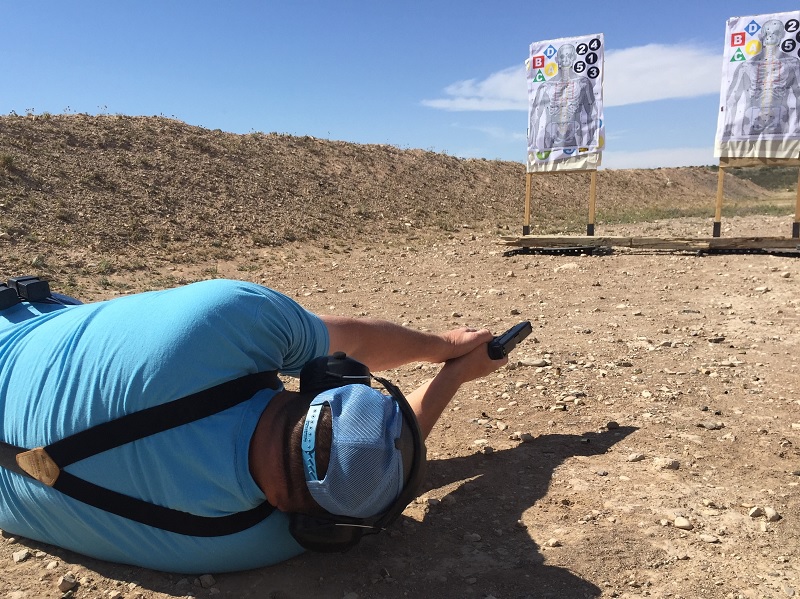Real Gun Games: Skill-Building Cleverly Disguised as Fun
Eve Flanigan 04.30.19

Deep in the heart of Arizona lives a man named Treg with an eye for art and a love for guns and people. He started his own company, Real Gun Games, where he sells targets and games of his own design. Treg agreed to share a few of these creations for testing, and the results have been quite unexpected.
What’s Different?
First, color; Treg is big on making targets interesting visually, and color is one way he achieves that. They’re also rich with shapes and other visual interest, i.e. numbers and letters. Most of these targets are three or more colors, creating more possibilities for games and drills where color/shape commands are used.
Second, drills; Treg has designed a plethora of targets with themes like “connect the dots,” with each bullseye-style dot being accompanied by an action, like “one hand strong side” for one-handed shooting, as well as building reloads into the patterns. Scoring instructions are printed right on the targets. In addition, laminated cards, about four inches square, allow the instructions to be read on a card-size version of the target from behind the firing line. An e-book also has letter-size printable versions of these. He’s even updated the venerable Dot Torture drill; superimposing it on an IDPA-style background and adding scoring rings.
Third, games; as the name implies. Some of the targets lend themselves to score-keeping and friendly competition. Treg’s YouTube channel shows participants using added physical challenges to include moving from marked points, to carrying heavy objects, and more. The crowning glory of the game side of this business is a series of card games, packaged as It’s Anyone’s Money Shot Command Cards. ($39.99). Drawing from the deck of very readable, laminated card that are about four inches square, shooters might find themselves performing a physical challenge, shooting with an alternate position or grip, losing a turn, shooting for double points, or other fun.

Range Day Report
We invited six shooters—two beginners and four intermediate – to test these targets on a range fun day, in addition to having used “Harvey,” the skeleton target, with its numerous and colorful aiming points, in a pistol/ammo accuracy test at 25 yards. By day’s end, we had a good sampling of opinions and insights.
To address practical concerns first, these targets are typical agency regulation size, 24 x 36 inches. So are the wooden frames we use. A couple targets, like Harvey, have mini-bullseyes on the edges. Numerous new holes were drilled in the frames, from both shot anticipation and margin of error at 25 yards, but for one target we pasted substitute focal points inside the 1.5 inches that’s backed by wood. On a larger backing, it wouldn’t matter.

“Harvey” the skeleton is a new favorite. This target is packed with center-mass and precision-shot zones of different shapes and sizes, has a sufficient number of letter/number/shape features to make a great command target, and is a great introduction to anatomical thinking where shot placement is concerned. I did provide feedback regarding the size of the facial trapezoid, which is too big for pistol targeting of a head-on central nervous system shot. Impressively, Treg emailed back a draft showing an accurate aiming zone.
Harvey is a great target for individual or group practice, and I plan on adding “him” to my target rotation this year. Every area on the figure, even the airspace between the elbows and rib cage, is labeled with a point value. This seems a little confusing but it’s also easy to ignore while using the target’s other assets.

Our intermediate shooters, and we instructors too, greatly enjoyed most of the “Connect the dots” targets we tried. These targets have separate bullseyes, six inches or less with progressive scoring zones, and round count/instruction information that flows from one aiming point to the next. The print is big enough for even my eyes to read at five yards, and Treg supplied laminated cards with easy-to-read instructions too. The Real Gun Games e-book has printable versions of the same. This is a real advantage for range safety and efficiency. Each target absorbed four to five rounds of shooting before becoming too shot-up to read—but Treg also makes colorful shot-covering stickers to extend target life or identify a shooter by sticker color.
Connect the Dots targets focused the group on performing reloads, one-handed shooting, and alternate grips. I give them high marks for practicality and for packing multiple skill practice into one target. The entire group did get a bit hung up on Connect The Dots #3, a reload drill-based target. It wasn’t immediately clear where the starting point was on the design, and we soon found ourselves making up rules to compensate—which worked well enough. Some targets have shooters start with 3-4 magazines with a specific round count in each, and in a group setting that, too, got a bit confusing, especially for the shooter with only a single magazine pouch. Some of the drills are designed for standard-capacity mags, so alternate courses of fire were crafted on the fly for people with lower round-count subcompacts.
Prior to this test, Treg advised the card game is a way to keep people engaged longer. On that advice, I put this exercise last on our range date, with each shooter having their own “Harvey” target. Admittedly, we pulled a couple cards from the deck we felt had no practical value, i.e. dual wielding and shooting with eyes closed.

Without entirely understanding the rules and how they relate, if at all, to target point value, we arbitrarily decided to give each good hit one point, and to allow the card-drawing player to assign one to three hits per draw. Players rotated between shooter, card-drawer, and scorekeeper.
I don’t think I’ve ever heard, or enjoyed, so much laughter on the range. With the card-drawing player allowed to assign the Harvey zone as well as number of shots, friendly rivalry grew. It was surprising to see middle-aged shooters happily drop for push-ups or do high-knees as a heart rate-enhancer before shooting, when physical challenges are often met with groans in a formal class. The laughter reduced anxiety, and even on the couple occasions when a timer was added to make a turn more difficult, laughter erased the usual performance stress. And in the end, the group had performed a respectable selection of real-world shooting skills.

The improvised score-keeping method we used turned out to be like something from Whose Line is it Anyway?, as in “everything’s made up and the points don’t matter.” The three game shooters, well-matched for skill level, ended with scores within a nine-point spread. They were so happy having done this game, they didn’t care. As an instructor, I was wholly pleased with how the game broke down normal resistances yet allowed them to practice new and old skills. One lesson learned: the game requires more studying than I devoted to it beforehand. I’d focused on the shooting instructions, but not point format. I did, however, remember paperweights. Keeping stuff from flying away is a necessity in our perpetually windy country. For this, two ammo cans worked well as hoppers, one for the draw stack and one for used cards.
In addition to the targets in this test, Real Gun Games has hundreds of other designs. Most are $1.99 each or 10/$19.90. They’re shipped rolled and in pristine condition. If you’re looking to get friends and family more interested in range time, or simply livening up your own routine, check out Real Gun Games.

